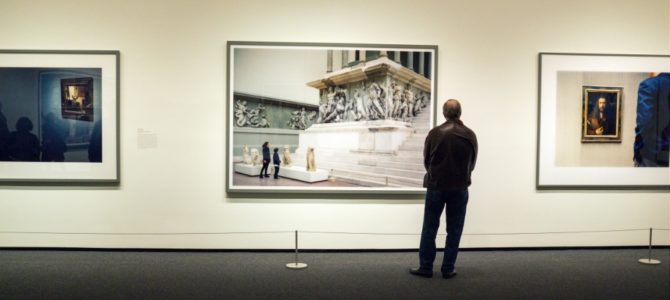
In recent weeks, museums in many American cities have reopened following months of closure due to COVID-19 restrictions. It’s good to see them making an effort to do so, even as each is taking its own approach as to exactly how much they feel comfortable with reopening.
With tourism down sharply across the country, and most people choosing to stay close to home, it might appear to be an ideal moment to venture out and spend some uninterrupted quality time with a favorite work of art or linger over a fascinating exhibition display. The reality, however, is unexpectedly different.
The National Gallery of Art, as of this writing, is only partly open to the public. To enter, one must reserve a ticket in advance, as the museum caps the total number of visitors in a given time slot. The East Building, which houses mainly Modern and Contemporary Art, is off-limits, while in the West Building, only the ground floor galleries may be visited. It was disappointing to learn that I wouldn’t be able to see the main floor galleries, where most of the museum’s greatest treasures are held, but as I was glad to finally return to a museum of any sort, I chose to make the most of what was available.
Offerings of the National Gallery
For starters, I revisited the excellent, temporary exhibition, “Degas at the Opera” in its final days, a show I reviewed for The Federalist in March when it first opened. I then wandered through the sculpture galleries looking for the more intriguing pieces, such as the bust of “Monsignor Francesco Barberini” (c. 1623) by the 25-year-old Gian Lorenzo Bernini (1598-1680), with its appealing contrast of smooth and rumpled carved fabrics, and the charming small bronze, “Walking Ostrich,” by an unknown French or German 19th-century sculptor of the “Animalier” movement.
I paused to examine, albeit somewhat disinterestedly, the jumble of antique furniture, silverware, ceramics, and the like from demolished Italian palazzos and vanished Federal mansions. I overheard one elderly visitor comment to another, “You know, I always forget that they have all of this flea market stuff down here.”
More appealing was a room hung with small, 19th-century French still life paintings, including several by the brilliant Henri Fantin-Latour (1836-1904). His “Still Life” (1866) for example, is both civilized and inviting, with its multi-colored carnations, lacquered tea tray, gilt-edged china, and a well-loved novel bound in teal paper. Everything in the picture is about refined color choices, surface reflections, and a sense of ease and comfort.
By contrast, there’s an almost violent sense of discomfort in his “Still Life with a Mustard Pot” (1860). A hefty knife dominates the center of the painting, its thick, blunt blade paralleled by the handle of the mustard spoon. Despite the evocation of a meal, there’s nothing to eat or drink here, unless of course digging into a pot of French mustard hits the spot for you.
As when comparing Fantin-Latour’s society portraits with his self-portraits, in these still life paintings it’s sometimes difficult to believe that these very different works came from the hand of the same artist, so strong are the contrasts between the refined and the brash.
A Somewhat Depressing Experience
Having seen just about all that was available to view, I headed to the main shop in the NGA’s West Building, only to discover that the vast space, usually crowded with tourists, was empty of both merchandise and people. The shop in the underground concourse connecting the two wings of the museum was still open but passing through long, eerily deserted spaces to reach it felt like wandering the halls of a hospital at 2 a.m. Similarly, the large underground café with its view of the I.M. Pei cascade was completely roped off, with only the espresso bar serving coffee and pre-made sandwiches to take away.
Overall the experience was, through no fault of the museum, somewhat depressing. Far from uplifting the spirits, the visit had the exact opposite effect. So about a week later, when I headed over to the Smithsonian American Art Museum and the National Portrait Gallery, I went with lowered expectations of what I would find.
Like the NGA, these two museums (which share the same gigantic building) are only accessible via a ticketing system. Both the SAAM and the NPG, however, allow current visitors to access not only the temporary exhibitions but also the majority of the permanent collections in their galleries. At the center of the complex, the glass-domed Kogod Courtyard — which for some reason always smells like a hotel atrium built in the 1980s — echoed the sound of running water moving along the decorative floor scrims, but very little else. On my visit, I counted a total of eight other museum patrons.
Things started reasonably brightly, as it was great to reunite with several old favorites. John Singer Sargent’s (1856-1925) intense portrait of “Elizabeth Winthrop Chanler” (1893) stared straight back at me as she always does, wringing her fidgety hands and trying unsuccessfully to sit still. Once again, “Dodges Ridge” (1947) by Andrew Wyeth (1917-2009) made me shiver, imagining the howling, freezing winds of a Nor’easter along the coast of Maine.
There was the gauzy, dreamy tranquility of what I always refer to as “The Dewing Room,” a corner gallery filled with Thomas Wilmer Dewing’s (1851-1938) ethereal images of willowy women, depicted both on canvas and on an over-the-top Steinway grand piano made for Teddy Roosevelt.
I also took the time to view the temporary exhibition, “Alexander von Humboldt and the United States: Art, Nature, and Culture,” whose run the SAAM has extended through Jan. 3. It was surprising to learn how, with only six weeks spent in America in 1804, the German philosopher, explorer, and naturalist Alexander von Humboldt (1769-1859) managed to have a sit-down with everyone from President Jefferson to members of the Peale art dynasty.
Besides around half a dozen portraits of von Humboldt himself, executed by several artists, as well as images of some of those with whom he met during his stay, the exhibition was able to incorporate a wealth of material illustrating his wide range of interests and causes, including notebooks, letters, and scientific instruments.
In addition to a magnificently reconstructed skeleton of a mastodon, for example, the show includes many luminous landscapes by Frederic Edwin Church (1826-1900) and Albert Bierstadt (1830-1902), sculptures and publications advocating the Abolitionist movement von Humboldt supported, and many works depicting Native American individuals, attire, and customs by George Catlin (1796-1872).
A particular favorite among these, “Buffalo Hunt under the Wolf-Skin Mask” (c. 1832-1833), shows two warriors dressed in wolf hides approaching a herd of buffalo somewhere along the Missouri River. The coloring is somewhat simple, and the shading a bit flat, but in this picture, Catlin evokes a real sense of dramatic tension as he forces the viewer to wonder, “What happened next?”
Viewing Excellence In the Company of Others
The show is a terrific example of what museums can do when they choose to do it well, as was the case with last year’s Smithsonian exhibition on the empresses of China. Here was someone I had vaguely heard of, but didn’t know much about, and led a fascinating life. By putting together a selection of art, objects, documents, film, and explanatory texts, the designers were able to create a kind of immersive, contextual display, both visually appealing and intellectually stimulating.
When you leave an exhibition knowing more than you did when you started, and wanting to do further reading on the subject, you know you’ve been to a good one. In the end, however, after considering this visit in tandem with that which I had made the previous week, I realized that it wasn’t the objects that I missed: it was the people.
No matter how good a permanent collection or temporary exhibition may be, viewing these things in the company of others transforms a museum visit from something self-centered into something shared. The conversations with and reactions of others, whether directed toward us or as observed from a distance, can have tremendous power over how we see the paintings, sculptures, and artifacts that we are collectively examining and discussing, as we make our way through the halls and galleries. It’s somewhat analogous to how, when you’re showing someone else around your hometown, you gain a new appreciation for the place, as you recount your perceptions and experiences, while simultaneously seeing things through someone else’s eyes.
This isn’t to suggest that one should avoid museums entirely until the lockdowns are finally past, whenever that is. Nor is it to say that there’s no value in having a few minutes alone with a favorite work of art. Yet I’m surprised to find myself admitting that, as much as I’m grateful to be able to go back to these places, for the time being, I miss the jostle, noise, and general chaos of my fellow patrons, more than I miss that lone, luminous Velázquez at the National Gallery.
Well, up to a point, anyway.









